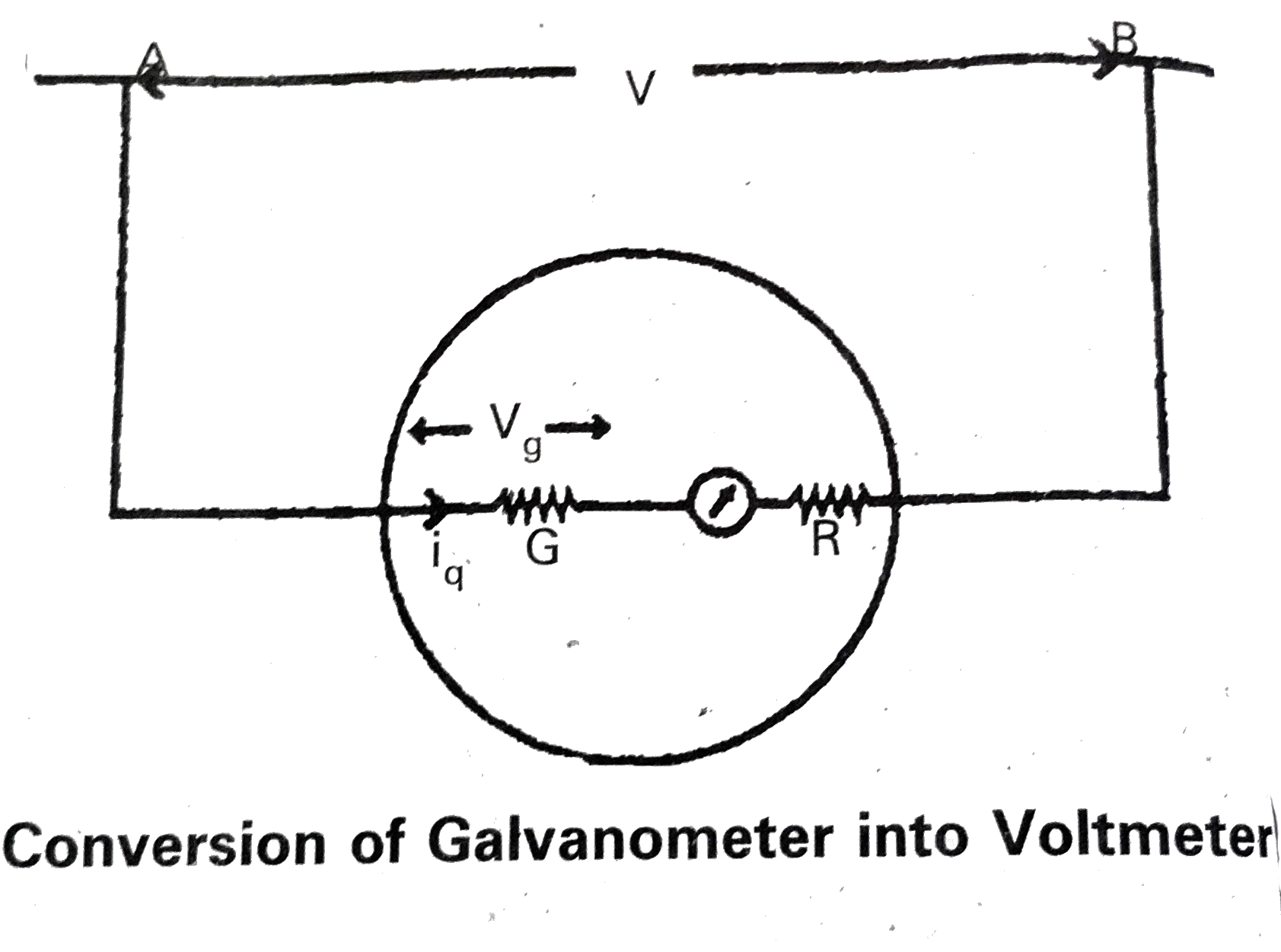How can galvanometer be converted to a voltmeter ? Why is the series resistance greater that the galvanometer resistance ? A moving coil galvanometer of resistance 5Ω can measure a current of 15mA. What is the series resistance required if it is to measure 1.5 V ?Solution in Telugu
Conversion of Galvanometer into Voltmeter : A galvanometer is converted into voltmeter by connecting a high resistance (R ) in series with it. Voltmeter is used to measure the P.D. between any two points in circuit and it is connected in parallel to the component of the circuit.
Let 'V' be the potential difference to be measured between the points 'A' and 'B'.
∴V=(R+G)ig [∴V=iR]
Where G = Galvanometer Resistance
ig= Current passing through the galvanometer Vig=R+G
∴R=Vig−G −(1)
The value of 'R' can be calculated using the above formula. If Vg is the maximum P.D. across the galvanometer then Vg=igG
∴ig=VgG −(2)
Substitute 'ig' in Equ (1)
R=VGVg−G=G(VVg−1)
If VVg=n⇒R=G(n−1)
Note : n=VVg is the ratio of maximum voltage to be measured to the maximum voltage across the galvanometer.
Series resistance is greater than galvanometer resistance because the current in external resistance and potential difference will be decreased and to increase the resistance of the galvanometer.

Solution for the problem :
Formula series resistance required, R=ViGRG
1.515×10−3−5=1.5×10315−5
=150015−5=100−5=95Ω∴R=95Ω
Topper's Solved these Questions
- MOVING CHARGES AND MAGNETISHMBOOK - VIKRAM PUBLICATION ( ANDHRA PUBLICATION)CHAPTER - MOVING CHARGES AND MAGNETISHMEXERCISE - TEXTUAL EXERCISES
14 Videos
- MOVING CHARGES AND MAGNETISHMBOOK - VIKRAM PUBLICATION ( ANDHRA PUBLICATION)CHAPTER - MOVING CHARGES AND MAGNETISHMEXERCISE - ADDITIONAL EXERCISES
26 Videos
- MOVING CHARGES AND MAGNETISHMBOOK - VIKRAM PUBLICATION ( ANDHRA PUBLICATION)CHAPTER - MOVING CHARGES AND MAGNETISHMEXERCISE - LONG ANSWER QUESTIONS
5 Videos
- MAGNETISM AND MATTERBOOK - VIKRAM PUBLICATION ( ANDHRA PUBLICATION)CHAPTER - MAGNETISM AND MATTEREXERCISE - Additional Exercises
19 Videos
- NUCLEIBOOK - VIKRAM PUBLICATION ( ANDHRA PUBLICATION)CHAPTER - NUCLEIEXERCISE - DAM SURE (VSAQ)
1 Videos
Similar Questions
A circular coil of wire consisting of 100 turns, each of radius 8.0 cm carries a current of 0.40 A. What is the magnitude of the magnetic field B at the centre of the coil ?
View SolutionTwo concentric circular coils X and Y of radii 16 cm and 10 cm, respectively, lie in the same vertical plane containing the north to south direction. Coil X has 20 turns and carries a current of 16 A, coil Y has 25 turns and carries a current of 18 A. The sense of the current in X is anticlockwise, and clockwise in Y, for an observer looking at the coils facing west. Give the magnitude and direction of the net magnetic field due to the coils at their centre.
View SolutionDeduce an expression for the force on a current carrying conductor placed in a magnetic field. Derive an expression for the force per unit length between two parallel current. Carrying conductors.
View SolutionWhy does a paramagnetic sample display greater magnetisation (for the same magnetising field) when cooled?
View SolutionThe half life of .58Co is 72 days. Calculate its average life.
View SolutionThe resistance of a moving coil galvanometer is 5 ohm . The maximum current it can measure is 0.015A . To convert it into an ammeter to measure 1.5A
View SolutionThe maximum current that can be measured by a galvanometer of resistance 40 Omega is 10 mA . It is converted into a voltmeter that can read upto 50 V . The resistance to be connected in series with the galvanometer is ... (in ohm )
View SolutionA moving coil galvanometer can measure a current of 10^(-6) A. What is the resistance of the shunt required if it is to measure 1A ?
View SolutionHow can galvanometer be converted to a voltmeter ? Why is the series resistance greater that the galvanometer resistance ?
View SolutionHow can a galvanometer be converted to an ammeter ? Why is the parallel resistance smaller that the galvanometer resistance ? A moving coil galvanometer can measure a current of 10−6 A. What is the resistance of the shunt required if it is to measure 1A ?
View SolutionA moving coil galvanometer of resistance 50 Omega gives full scale deflection for a current of 50 mA. How can this galvanometer be used to convert it into a voltmeter which can measure voltage upto 200 V ?
View SolutionA galvanometer of resistance 40Omega can measure a current of 10mA To convert it into a voltmeter of range 8V the required resistance is ___________ Omega .
View SolutionState the principle of working of a galvanometer. A galvanometer of resistance G is converted into a voltmeter to measure upto V volts by connecting resistance R_(1) in series with the coil. If a resistance R_(2) is connected in series with it, then it can measure V/2 volts. Find the resistance, in terms of R_(1) and R_(2) , required to be connected to convert it into a volt meter that can read upto 2 V. Also find the resistance G of the galvanometer in terms of R_(1) and R_(2) .
View Solution1000Ω प्रतिरोध कुण्डली का एक गैल्वेनोमीटर 5 mA की धारा पर सम्पूर्ण विचलन दर्शाता है। 50 V माप प्राप्ति के लिए इस गैल्वेनोमीटर को वोल्टमीटर में परिवर्तित करने के लिए कितने प्रतिरोध की आवश्यकता होगी तथा इसे किस क्रम में जोड़ना होगा?
View SolutionThe maximum current that can be measured by a galvanometer of resistance 40 is 10 mA. It is converted into a voltmeter that can read upto 50 V. The resistance to be connected in series with the galvanometer is ........ (in ohm)
View Solution
